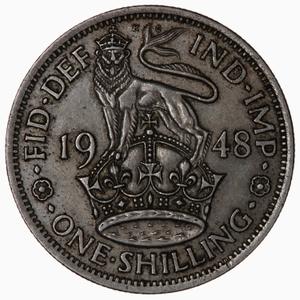| Coin | Shilling 1948 English |
|---|
|
The pre-decimal shilling (1s), also abbreviated in sums as e.g. 1/- for one shilling, was a unit of currency equalling one twentieth of a pound sterling, or twelve pence sterling; the "s" in the abbreviation is not from "shilling" but from "sestertius" - the Roman coin which was the ancestor of the denomination. It was used in the United Kingdom, and earlier in Great Britain and England.
The denomination had undergone several earlier changes, including an English Lion on a crown type (1902 - 1927). In 1927, most denominations were re-designed by George Kruger Gray. The other denominations got new themes, but the shilling retained the general idea of the English Lion on top of St Edward's Crown; it was just re-designed to look more streamlined, and the crown is seen from a different aspect. The design was issued until the end of the reign of King George V in this form, then during the reign of King George VI two Tudor roses were added and the coin was re-branded the "English Shilling", with a parallel Scottish Shilling introduced in 1937.
In 1953, the design was superseded by a new type of English Shilling featuring the crowned Shield of England.
The composition was 50% (0.0903 oz ASW) until 1946, after which time it was debased to copper-nickel together with the rest of the silver coinage. When the currency became decimal in 1971, shillings were re-denominated as five new pence; they remained legal tender until 1990, when a smaller type of five pence replaced them. Thus, a shilling coin issued in 1948 was legal tender for 42 years.
|
|
|
| Obverse | |
|---|

The obverse of the coin shows the bare (uncrowned) head of King George VI facing left.
Below the neck truncation in small letters, the artist's initials HP (for [Thomas] Humphrey Paget).
Around, the monarch's legend: GEORGIVS VI D : G : BR : OMN : REX. Translated from Latin: George the Sixth, by the Grace of God, King of all the Britains.
|
|
|
| Reverse | |
|---|

The centre of the reverse shows St Edward's Crown surmounted by the crowned Lion of England. Named after Saint Edward the Confessor, the crown has been traditionally used to crown English and British monarchs at their coronations since the 13th century (with a two-century gap between 1689 and 1911). The lion is walking to left, its head turned to face the viewer. Above the lion's tail in small letters, the artist's initials KG (for [George] Kruger Gray).
Divided by the crown, the date of issue 1948.
Within a beaded border, around above is the continuation of the monarch's legend: · FID · DEF IND · IMP · (abbreviated from FIDEI DEFENSOR INDIAE IMPERATOR - Defender of the Faith, Emperor of India).
Around below, the denomination and the date of issue: · ONE SHILLING ·. Two Tudor roses before and after the denomination, which were not present in the pre-1937 design, mark the coin as the "English Shilling" of the year; a Scottish Shilling was also issued in 1948, with a different reverse. |
|
| Reverse Inscription |
· FID · DEF IND · IMP · · ONE SHILLING · 1948 |
|---|
|
| Edge | Milled | Edge Inscription | None |
|
| Notes | Between 1937 and 1970, British shilling coins were issued with English and Scottish design each year. This is the English design. |
|---|
|
| Included in Set |
|---|
| The 75th Birthday of His Majesty King Charles III Celebration Coinage Collection, mintage 1,000, limited to 1,000
|
| His Majesty King Charles III 1948 and 2023 Coinage Collection, mintage 2,023, limited to 2,023
|
| The Coronation of His Majesty King Charles III Celebration Coinage Collection, mintage 1,000, limited to 1,000
|
|





 Search for United Kingdom: Shilling 1948 English on eBay
Search for United Kingdom: Shilling 1948 English on eBay 

